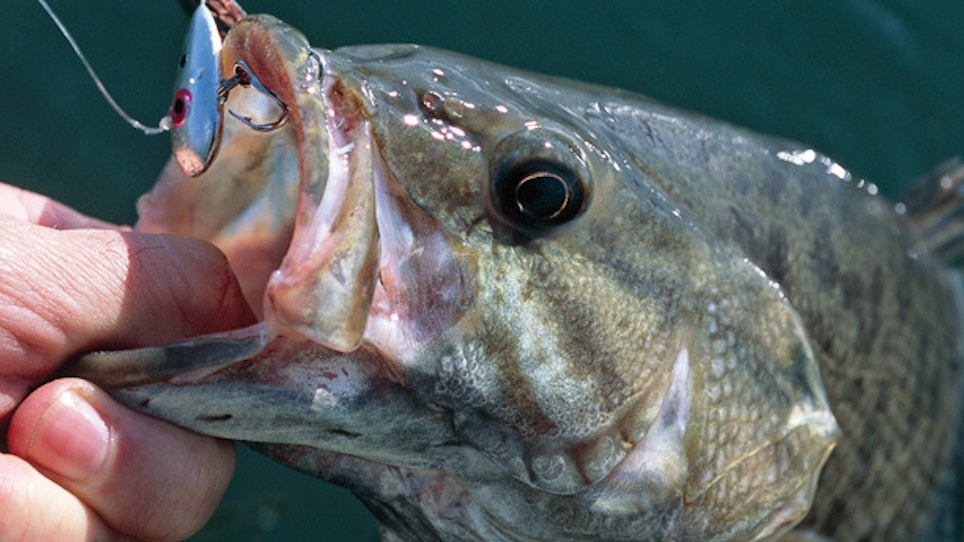Compared to no-brainer lures like crankbaits and spinnerbaits, metal baits require a high degree of angler skill to be worked properly. But when bass in Dixie’s reservoirs go deep in winter, heavy metal will outproduce other lure styles 10 to 1. Here’s a short course in metal magic.
 Blade Baits: Vibration Plus
Blade Baits: Vibration Plus
Blade baits including the Silver Buddy, Bullet, and Sonar are stamped slices of metal weighted at the belly or head. Their compact profile matches the small baitfish bass feed on in winter, and their tremendous vibration provokes savage reaction strikes. Choose a ½-ounce blade for winter application, silver or gold on sunny days; white, orange or chartreuse on cloudy days.
A 6 1/2-foot, medium-action rod is a good choice for blades. Spool up with 10- to 14-pound mono and attach your line to the lure with a small wire snap or swivel. Try this basic blade retrieve:
(1) Make a long cast to a deep point or submerged ledge. Keep the rod at 10 o’clock while the blade sinks on a tight line.
(2) Immediately after the lure hits bottom, lower the rod to 9 o’clock, reel up slack and pop the rod back sharply to 11 o’clock, hopping the lure off the bottom.
(3) Lower the rod back to 9 o’clock as the lure drops.
(4) Pop the rod back to 11 ‘clock, and repeat. If you feel a thump or see your line hop, set the hook.
Tailspinners: Compact, Yet Deadly
The late Eufaula, Alabama luremaker Tom Mann hit a home run when he designed his Little George tailspinner nearly 50 years ago. This tiny slab of metal with a single spinner blade at the rear has racked up countless numbers of giant bass over the years. Today, Mann’s Bait Company still cranks out zillions of Little Georges; it’s said to be the largest-selling metal bass lure of all time. There’s been a recent resurgence of interest in tailspinners among tournament bassers, prompting the introduction of a number of new models including the Stanley Shad and Gama Shad.

Tailspinners are the most compact all metal baits, making them a solid choice in the most frigid water, when the digestive processes of bass slow dramatically and tiny forage is preferred. For most winter bass applications, choose a ½-ounce lure in a shad or chartreuse pattern, again depending on water clarity and cloud cover. Fish a tailspinner anyplace you’d fish a blade bait -- it’s equally effective in the super-deep zone, and actually better than a blade when the water is a bit murky after a heavy rain. A tailspinner also works great around deep submerged standing timber. Use a 6 1/2- to 7-foot medium-heavy rod and 12-pound line in rocky lakes, 20-pound in timbered reservoirs. No snap or swivel is needed.
Tailspinners are designed to be hopped off the bottom. Here’s how to do it right:
(1) Make a long cast past your target, keeping the rod at 11 o’clock as the lure drops.
(2) When the tailspinner hits bottom, immediately lower the rod to 9 o’clock while reeling up slack.
(3) Raise the rod back sharply to 11 o’clock while turning the reel handle. This causes the bait to shoot off the bottom frantically.
(4) Repeat steps 2 and 3 back to the boat. Vary the speed of your rod lift/reel cranks until you find the right combination to trigger strikes.
Jigging Spoons: Solution for Suspenders
When bass are suspending in deep, cold water, a jigging spoon is your best option -- in fact, short of live bait, it may be your only option. Popular lures in this genre include the Hopkins, Mann-O-Lure, Crippled Herring, Lazer Eye and Strata Spoon. Use a ½- to 1-ounce spoon for most winter applications. Fish reflective colors on sunny days, white or chartreuse under cloud cover.
Look for suspended bass on your graph at the ends of deep points, around steep rock bluffs and in the middle of deep V-shaped tributary arms (“hollows”). Don’t be concerned if the bass you spot are super-deep -- guides on Georgia’s Lake Lanier and Tennessee’s Center Hill Lake routinely catch feisty spotted bass suspending 75 feet deep! Thirty to 50 feet is common for largemouth and smallmouth bass in midwinter.

A 6- to 6 1/2-foot medium-heavy rod is ideal for spoon jigging. Braided lines are perfect for this application -- they have zero stretch, allowing you to instantly detect the lightest bites in deep water. Use a swivel ahead of the spoon to prevent line twist. A bow-mounted depth finder is highly recommended for vertical jigging. Attach the transducer to your trolling motor so you can stay on fish constantly while working your spoon. Here’s how to spoon up bass from deep water:
(1) Position your boat directly above baitfish/bass visible on your sonar.
(2) With the rod at 9 o’clock, drop the spoon to the level of the fish. If in doubt as to the spoon’s depth, count off feet while stripping line from the reel manually.
(3) Lower the rod to 8 o’clock, then snap it up to 10. Pause for a split-second, then snap it up higher to 12. The snaps should be sharp and deliberate, like cracking a whip.
(4) Lower the rod back to 8, feeling the spoon back down. Don’t lower the rod too quickly or you’ll throw too much slack in the line. Don’t lower it too slowly or the spoon won’t flutter enticingly.
(5) Repeat steps 2-4.
Remember that bass suspending in cold water are usually lethargic. Don’t just jig the spoon a few times and move on -- keep working the fish slowly and methodically. And here’s a cool tip: keep a waterproof marker in your pocket. When you hang a bass, quickly mark the line at the rod tip before reeling in. This allows you to drop the spoon to the exact same depth every time.






